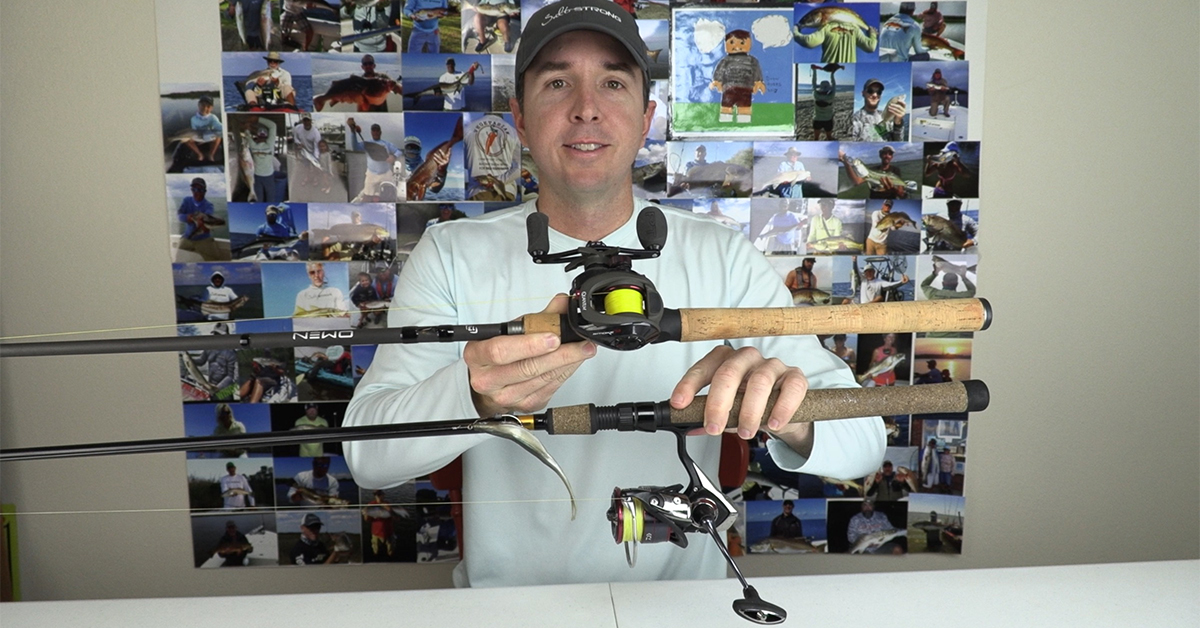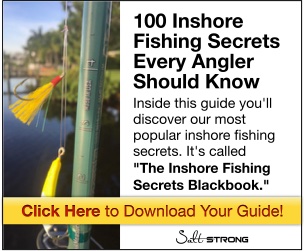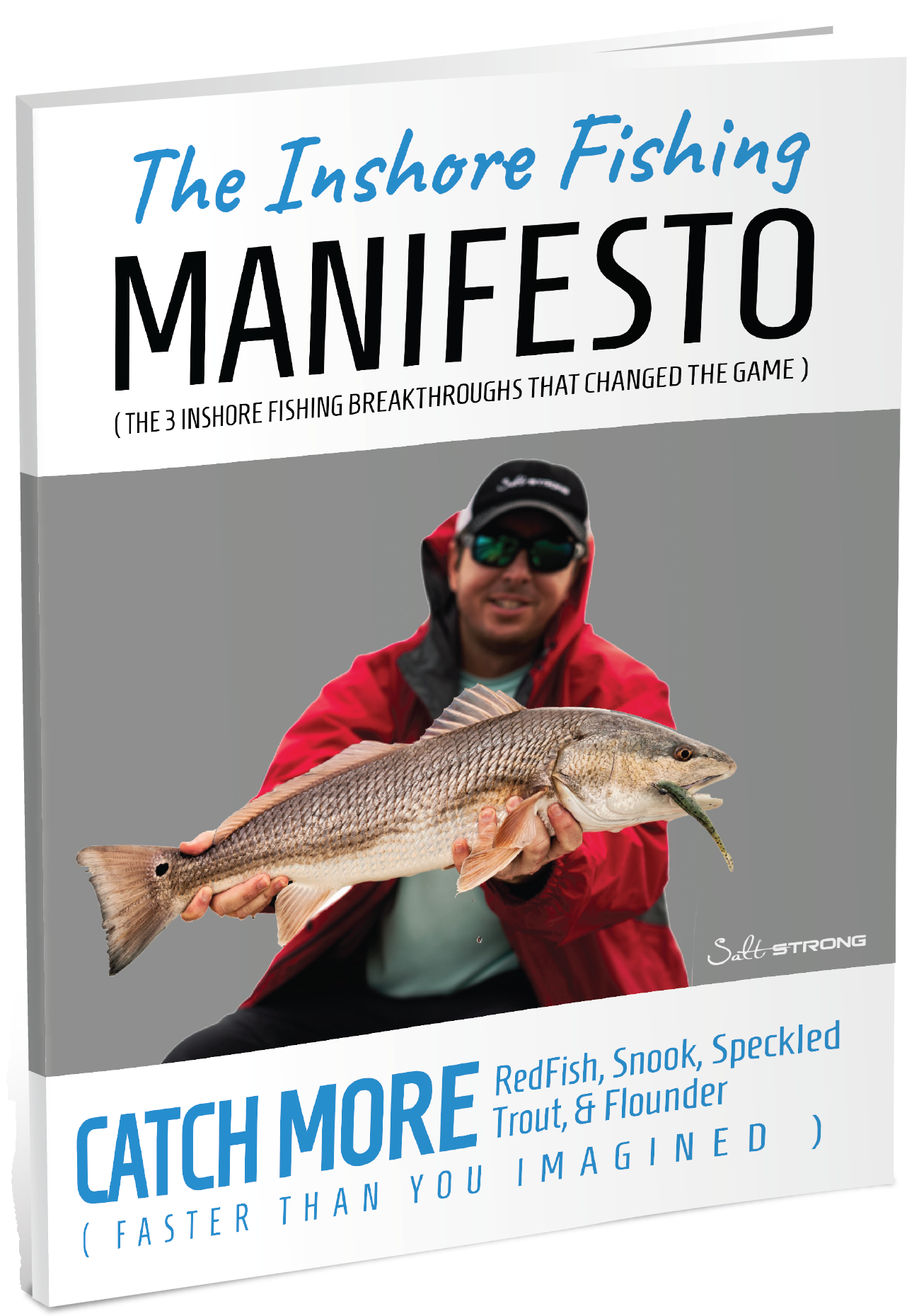The Best Type Of Rod & Reel For Inshore Fishing [Baitcasting Vs. Spinning Gear]
- By: Luke Simonds
- on

Trying to decide between baitcasting and spinning gear?
Like many of you, I was originally a bass fisherman before I got into saltwater fishing.
Naturally, I used a baitcasting reel when I started saltwater fishing, but I really struggled.
Eventually, I gave in and switched to spinning gear and I started catching more fish!
Want to know why?
Check out this video where we break down the pros and cons of baitcasting reels vs. spinning reels, plus we talk about what gear we use today.
Enjoy!
(P.S. What’s your experience with baitcasting vs. spinning gear? Let us know in the comments!)
Baitcasting vs Spinning Gear [VIDEO]
Related links:
Conclusion
What are your experiences with baitcasting vs. spinning gear?
What are you using now?
Let us know in the comments below!
Know someone who might enjoy this video? TAG or SHARE this with them!
 FREE GUIDE
FREE GUIDE
“The Inshore Fishing Manifesto”
The 3 Must-Know Breakthroughs To Consistently Catching Inshore Slams Faster Than You Ever Imagined.
Grab Your Free Copy Here
Related articles:
Related categories:
STOP WASTING TIME ON THE WATER!
Do what the “SMART ANGLERS” are doing and join the Insider Club.
Here’s what you’ll receive today when you join:
- Weekly fishing reports and TRENDS revealing exactly where you should fish every trip
- Weekly “spot dissection” videos that walk you through all the best spots in your area
- Exclusive fishing tips from the PROS you can’t find anywhere else
- Everything you need to start catching fish more consistently (regardless if you fish out of a boat, kayak, or land).











I have watched several of your reviews of rods and narrowed my selection to the TFO PSS 764-1 in 7’6″ Medium. Your store is out of stock. Will you be getting more in? If not where can I purchase this?
I carry one baitcaster during the really hot water periods for deep water vertical jigging. In the ICWW around St Augustine, there are some 40 foot holes – and the ledges around them hold some serious fish during the hot months. The best way to fish that water is vertical jigging and its a lot more effective with a level wind than a spinning reel.
1. Practice, practice, practice, that’s the key to casting. Left hand & right hand. 2. Setting up your bait caster reel for the lure/bait you are throwing. 3. Length of the rod, longer for flats, distance, and shorter for skipping, better control, my opinion.
I always have a bait caster onboard for flipping docks and skipping under mangroves. I’m more accurate with the bait caster than a spinning reel, I can control the distance with my thumb. Harder to do with a spinning reel, my opinion. I skip better with a bait caster than a spinner.
I agree, lightweight use a spinner.
I have a bait caster Abu Garcia, Revo Inshore, reel on a 6’10” rod for saltwater use. Love the reel!
Practice, practice, practice.
Thank you Luke for the heads up on this commentary. Very informative and helpful!
My pleasure Steven!
Very interesting video, I also started off using baitcasters in freshwater for largemouth bass in Florida, then moved up north and went to light spinning reels for smallmouth bass. Return to Florida and started saltwater fishing for all species, using both baitcasters and spinning reels. Now I am a tarpon addict, jumping 824 tarpon last year, while landing 425. About half of these on swimbaits, the rest dead baits cast to visible tarpon or live bait. All I use for tarpon is spinning reels, from Cabo 120s lined with 150 pound braid to 3000/5000 series reels with 30 pound braid. I believe a spinning reels has lots of advantages over a baitcaster when casting large baits (9 inch spoolteks) over bait caster when fishing the Everglades or casting a dead croaker next to a shrimp boat dragging nets in North Florida. Just one persons opinion.
I also did a lot of still-water freshwater bass fishing with baitcasting (and spinning) reels in my younger times, but always “left handed” ones. I can’t figure out why, with most people being right-handed, the reel manufacturers want us to work lures and fight fish with our left arms while using a right-handed baitcasting reel. I haven’t been able to find a reasonably priced left-handed saltwater model, so I tried out a righthander. This taught me something completely unexpected – I have very specialized muscle memory in both arms. The right arm knows how to do those little “pops” that make the lure hop and swim in the water to trigger strikes, and the left knows how to reel synchronized with that action – and both know what to do on a strike. Reversing the roles just doesn’t work – I could cast the right handed baitcaster fine – but I couldn’t “fish” it worth a damn. Maybe you don’t have this problem – I note the reel in your video is right handed – but it’s spinning gear for me. To see what I mean, move the handle on a spinning reel over to the right side and give it a whirl.
I believe that it just takes time to let the muscle memory develop… I remember feeling awkward when I switched from baitcasting (handle on right) to spinning (handle on the left) years ago.
And I felt the same way when I brought out the baitcaster recently after years of not using one… just took a little bit of time before it felt natural again.
I agree completely Dave!!! I can’t get the twitch rhythm on the left and reel with the right. I have a couple lefty bait casters and all my spinners have left hand cranks.
Are your lefty baitcasters designed for salt water? … and if so, what are they (hopefully less than $300!)
A agree with you that spinning is more versatile. I have used both but due to medical hand issues I am forced to baitcasters reels. When Diawa came up with the skirted spinning reel it was a game changer. Before that reels like the Mitchell 300 line would get under the spool. The first Diawa skirted spinning reel was CC or silver next came GS or gold then finally the BG or black gold ind it was the state of the art. Back then I could buy a new BG 15 for less than I spend on braid on my reels. I still have a few and they still work. We had to change the mono on those reels every two or three outings luckily Ande or Berkley line was about $5.00 for 2000 yards. You could get about 100 yards of 8 lb on the original BG 15. When I was able to I used both spinning for jigs and baitcasting for plugs. Miss those spinning days
Thanks for making time to leave the helpful comment Sam!
Luke to be fair I have asked Tony about these things, but I would really appreciate your feedback as well. I am about a 1month old member and I have watched almost all your videos including your kayak fishing course. Great Stuff!! I have a couple questions and if I am to post these somewhere else please let me know. I try to be judicious with my questions but need your help in these areas. I know there is a bit of info here but please help as I haven’t been able to get answers to these questions:
1. I have heard 2-4 feet of leader material, but when I push 4 feet of leader I cannot cast as accuratley or with the same amount of force as a shorter leader (the dart cast you showed me). What is your average leader length? What leader do you typically use, I have conisdering using the Berkley Vanish MAINLINE given your recent findings for my leader.
2. Much of the waters you fish are clear, I live in Naples and fish the back water which is almost always brown due to the tannins in the water as I am almost always fishing near mangroves. What if anything should I be doing different given I don’t get to sight cast much at all. Should my lures (gulp jerk shad, gulp shrimp), or presentation change etc.
3. There is not much grass or grass flats down here, mostly tannin stained water with sandy bottoms, You seem to target fish on the grass flats. How should I adapt, what would you do? There is Estero Bay up the road but I have never fished it., but understand it “may” hold grass flats.
4. I have been using the maps as you suggest, but when on the water should I be using my google maps to actually locate the drop off. In your videos you are often further off the shoreline than I ever am when fishing. I am usually fishing up next to the mangrove line and working lure back towardls my kayak. PS if you do use the google maps on your phone how the heck can you see them, In the sun I can hardly see my map.
5. Serious thoughts on Fishfinder and what do I really need (hook5 etc?). Being that I fish in 1-3 foot of water often will the passing over a 3 foot drop off from 1 foot be a place I should cast? I am jlust not sure how much a 500 investment in a down and lateral scanning fish finder (my hobie outback 2019 supports lateral scanning) would help me as I have never used one. And on top of that do they work in shallow water, are the helpful in shallow water?
THANK YOU SO MUCH! And my apologies for all the questions.
Great questions Aaron!
1) I start my leaders at about 24″ to 30″ (shorter spectrum if in need of accuract casts and longer if blind casting the open flats), and keep them until they get widdled down to about 18″ before reloading. As for material, I have been switching from traditional mono to fluoro (leader fluoro and mainline fluoro), and I can’t tell a difference between any of them… even when using traditional mono fishing in the very clear Biscayne Bay waters in the middle of the day: https://www.saltstrong.com/insiders/key-biscayne-exploration-trip-spot-dissection-report/
2) The same lures work well down there too. I lean a bit more toward paddle tail lures when fishing less clear water because they put out some more vibration in the water to help the predators hone in on the meal… here’s a recent report I posted from a trip to waters near you recently: https://www.saltstrong.com/articles/post-cold-front-inshore-slam/
3) Target areas with multiple forms of structure whenever possible. Since there’s not as much seagrass in your region, it’s smart to look for combinations of island points and oysters, docks, and/or depth changes.
4) When checking the phone while on the water, put your back to the sun and get your phone in the shade… putting a towel over your head is the best, and putting the phone under your shirt is the 2nd best
5) The best depth finder for an inshore fishing kayak is a good pair of polarized sunglasses, and the 2nd best depth finder is a paddle (just dip it into the water straight down and feel how deep it is). A majority of the fish are holding in less than 5 ft of water most of the year, so going through the effort of buying, installing, and maintaining a depth finder is most often not worth it.
Thanks Luke, I am trying to learn the fishing here in Chokoloskee and these responses will help me here, most of the inside water is very muddy and I am trying to figure out how to tell which 20 feet of mangrove edge to fsh out of the 200 mles I am looking at! The courses have helped me a lot.
My pleasure Dave! When in doubt, go with the zones that are holding the most birds and baitfish activity are also close to structure (mangroves, bars, grass flats, etc.)
NICE TO HEAR FROM A FELLOW FISHERMAN, HOWEVER, I TAKE OFFENSE TO YOUR COMMENT ABOUT COMPARING THE BAIT CASTING VERSES SPINNING REELS. I AM A SALTWATER FISHERMAN & HAVE ALWAYS BEEN ONE SO YOU CAN UNDERSTAND MY FRUSTRATION HEARING SOMEONE TALK ABOUT SOMETHING CALLED “BAIT-CASTING”. THERE IS ABSOLUTELY NO COMPARISON,WITH ALL DUE RESPECT.I HAVE EVEN USED SPINNING EQUIPMENT IN FRESH WATER.
I LIVE ON THE EAST COAST(CHARLESTON,S.C.) & HAVE THE PLEASURE OF FISHING BOTH “FRESH & SALT WATER”,HOWEVER MY PREFERENCE IS SALT. I FEEL THERE ARE MANY MORE VARIETIES OF GOOD FISH & LARGER ONES TO BE ENTERTAINED BY.
I RESPECT WHAT YOU ARE SAYING BUT LIKE MOST GOOD FISHERMEN, I WILL STRETCH MY STORY JUST A LITTLE.
THANKS FOR YOUR ARTICLE,
ERNIE
Sorry to see that I struck a nerve on this post. I am totally open to all viewpoints about the pros and cons of these two reel types, so please feel free to share any specifics that you have experienced when trying each type out on the water.
For me approaching a day of fishing presents opportunities to rely upon established habits with familiar equipment, blended with chances to experiment and learn how to use novel gear. At the end of the day, the target species of fish is gonna go about its very same day regardless of the fisherman’s choice of equipment. Bait vs spin gear, like the choice of bait(s) (size, weight, color etc), tidal flow, day light, water temperature, etc. selection are all elements of the daily sport of fishing.
For top water (0 – 15 feet) spinning is my preference for each reason you highlight. Wind knots are easily managed, after you have ‘matured’ the hard way. Meaning, observing a school disappear or move out of casting range as you untangle your mess, is a good motivator not to do that again. Similar to learning to regulate thumb pressure on to avoid a bird’s nest.
My preference for live lining bait free spool, or bottom fishing in depths and/or structure; the gear ratio, drag stopping power, and short stout rod length, is the bait caster. Also for heavy plugs into the wind/rain. Other conditions call out for the grace of an 11 foot spin surf caster, as opposed to the brut force of a crane.
Calm Seas are not a training ground for proficient Captains. Whether your present familiarity is spin or bait casting, getting out of your cove and into open waters is a great day on the water!!
Tight Lines!
John
Thanks for making time to leave the helpful comment John!